Workplace mental health has always been an issue, but businesses must do more to engage with staff since COVID-19, says Ashley Lourens, Head of Wellbeing and Therapist at workplace wellbeing platform Plumm.
COVID-19 and the cultural shift in mental health
Pre-pandemic, firms mostly dealt with employee mental health on an individual basis, fast-forward two years, and the entire workforce has been impacted mentally by COVID-19 in some way. In short, these zeitgeist mental health issues are now too pervasive to be brushed under the carpet as a private matter, and collective action is needed, says Lourens.
COVID-19 brought on another change, too, she argues, namely the acceptance that humans are fallible beings, including in the workplace. If pre-pandemic workplace mental health issues were about getting through it, post, it’s about openness and destigmatising mental health conversations: “Companies are starting to put this culture of focusing on mental wellbeing at the forefront, which is not something they were focused on as much before the pandemic.”
COVID-19 mental health symptoms
Whether companies want to prioritise mental health today is irrelevant. The fact is they must if they want to retain happy, motivated, and productive staff and not lose them to the great reshuffle. To help firms uncover the biggest mental health symptoms today, Lourens’ team conducted research which found that stress, anxiety, loneliness, and general uncertainty are among the core workplace mental health issues related to COVID-19.
“We’ve seen higher rates of agoraphobia, which is the phobia of being in enclosed crowded spaces. But there are many cases of general anxiety too.” She adds that depression has also been a common mental health symptom due to feelings of isolation, loss of control, and bereavement.
COVID-19 is a global health crisis on a scale society hasn’t experienced since the Spanish Flu of the early 1900s. So, has COVID-19 changed the psychology of people? Lourens says it’s too early to tell and adds that as people aren’t a monolith, they will all have reacted differently.
However, she says that people with previous mental health issues might find bouncing back from the mental health impact of the pandemic harder than those whose issues arose during this time. For the latter group, she is confident that if businesses have the right adjustments in place, they can make a full mental health recovery. But what do these adjustments look like?
Adjustments to improve employee mental health
On a company-wide scale, Lourens says sensitivity and awareness about mental health are key and include training leadership to be aware of the mental health impacts of the pandemic. Psychological safety is crucial here, namely “creating an environment where people can open up.”
This time, interaction must come at both the personal and organisational levels. It is essential that all leaders embody a “company-wide culture” of focusing on mental health “from how they communicate that from the initiatives they do.”
At the organisational level, leaders can send a company-wide message that managers will be checking in with staff about their mental health to prevent anyone from feeling ambushed.
On an individual level, managers should send short personal messages asking staff to book a chat to discuss how they’ve been coping with COVID-19. Here, she says managers must relay that they are always available to speak about any mental health concerns.
Check-ins with staff are key, but these must be private and casual, not on group calls, as many won’t feel comfortable speaking up. Conducting anonymous employee mental health surveys is another idea that Lourens supports, as is providing access to workplace mental health resources such as video therapy and stress management tools.
While Lourens says this “multi-layered approach” can help improve workplace mental health, leaders must be trained to encourage employees to access these services and crucially overcome the stigma of doing so.
For this to be effective, she says leaders need soft skills, such as being able to listen. This includes being able “to approach someone that they think is struggling” and giving space to the other person to share without commentary or judgement. “The key here is not trying to solve problems for that person or judge them by saying, ‘oh well, I wasn’t affected by COVID-19 in that way.’ This really requires the leader to have empathy, listen, and communicate care, empathy and support.”
While remote and hybrid styles have been lauded as more wellbeing-friendly ways of working, Lourens warns that mental health risks can also come up.
COVID-19 working styles – risks to be aware of
She says declining mental health is harder to spot over video and instant messaging than in-person. Managers can more obviously see signs of physical and mental health burnout. Remote working, she adds, can trigger feelings of isolation, stress, and even threats to personal safety, especially if employees are working in home environments with mounting childcare responsibilities or threats of domestic abuse.
Overworking from home and not taking breaks is another trend she’s seen emerging, affecting employee mental health.
For remote organisations especially, mental health interventions must be intentional. For Lourens, this includes leaders simply telling their staff to take frequent breaks and stick to their contracted hours, as well as having regular video calls with teams to ensure connection.
For Lourens and psychological researchers like her, the mental health impact of COVID-19 era working styles is only just being studied. However, she says the symptoms of mental health decline can be the same as in physical workplaces, although they manifest slightly differently.
“When people generally struggle with their mental health, they withdraw socially and physically. So, when you see someone switching off their camera, that can be a sign of withdrawal. It can mean I don’t have the energy to interact at that level, or the energy for people, or maybe not feeling presentable because I haven’t had that energy to keep up my hygiene. Similarly, if someone is usually chatty in the chat group but is suddenly quiet, that’s something to notice.”
Workplace mental health issues existed before the pandemic, and they continue today. Now, there’s a new cohort of workers with COVID-19 related mental health issues. If employers don’t help this group, along with those whose mental health issues have been exacerbated by the pandemic, they could be facing the greatest mental health crisis in business history.









